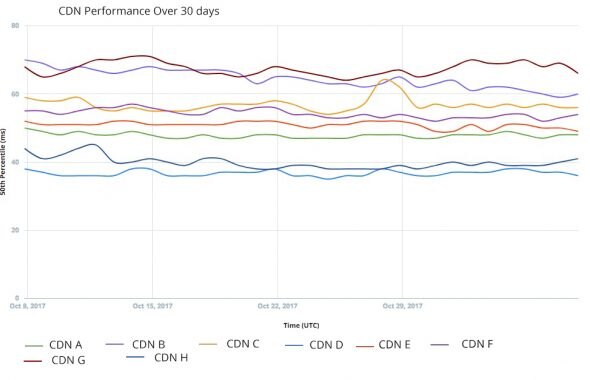Running a global high-performance web platform has never been more challenging. Web operators must contend with tuning site delivery to perform equally well from Beijing to Boston, Savannah to Sao Paulo. Site owners must also deal with accelerating device proliferation and social media-induced traffic spikes.
While website performance now influences whether a quarter’s revenue numbers are made or missed, it is also difficult to stay a step ahead of your customers’ expectations. Today’s online content creators need to manage expectations for a global Internet user base that now reaches over two billion people – 30% of the world’s population.
How One AI-Driven Media Platform Cut EBS Costs for AWS ASGs by 48%

CDNs provide a way to both bring content closer to your end users and distribute the load across multiple servers. They are essential for serving your global user base. However, not all CDNs made are equal. Some CDNs work better in different parts of the world. Using a best-of-breed approach for each location allows you to takes advantage of the fastest, most reliable CDN for each part of your network. This is why a multi-CDN strategy is becoming more widely adopted.
Reasons for a multi-CDN strategy
To understand what a multi-CDN strategy is, we have to look back at the era of using single CDN service provider to speed up the performance of your website.
In the past, a website owner would shortlist a few CDN providers and choose a single CDN to improve the performance of their website, when comes to page loading time or content downloads. Their choice might be based on the CDN’s coverage or the cost of the traffic. It could be because of their support service, or how user-friendly the CDN system is – there are many factors, but typically they would only choose one provider.
The variability in CDN performance is why it is important to implement a multi-CDN strategy in your network architecture. A single CDN may not address all of your customers’ needs. Like internet speed and quality, individual CDNs vary in their performance across different global locations. Delivery can be also impacted for some customers due to local outages or unexpected high internet traffic volume in the local area.

As obvious, the results vary depending on CDN providers, and they also vary depending on different geographical regions. What if you could hop from one CDN provider to another, at all times? Redirecting your user’s requests to the optimal content source based on your business needs. This is known as Multiple Content Delivery Network, or multi-CDN. Such diversification of your CDN providers is known to be less risky. And you can easily balance availability and performance of your website by loading various servers on the cloud, differently.
Multi-CDN Benefits
In short, we can say that a multi-cdn stategy offers these benefits, when compared to using only a single CDN:
- Increased performance
- Removing the single point of failure
- Geolocation coverage
- Decreased costs & better ROI
Increased performance
If a decline in performance leads to lost business, then it should follow that performance improvements should lead to an increase in business, and this has proven to be true. This correlation has been demonstrated, in that a faster pageload-time leads to more frequent
and longer visits, as well as fewer bounces. Mozilla provides a compelling real-life-use case: Through optimizing their Web pages, they boosted conversions by 15%, leading to a potential increase of over ten million downloads.
It should be noted that improving performance not only increases a site’s conversion rates, it can also have a significant impact on search-engine rankings. Google includes overall site speed as part of their Page Rank algorithm. Improving your Web or mobile applications’ performance is an ongoing process.
Removing the single point of failure (SPOF)
Multi-CDN strategy offers another great advantage over a single CDN. Performance is a great goal, but removing your single point of failure (SPOF) is an equally important benefit. Any system architect knows that a SPOF will eventually knock you offline. While CDNs are built to be redundant and have certainly improved over the last 10 years, there can be no doubt that CDNs have occasional technical challenges that can affect website performance. By moving your mobile app or Web property to a multi-CDN delivery strategy you make your entire system more resistant to failure.
The best solution is actually to use several providers that, when combined, offer a fully rounded delivery solution on a global scale. This ensures a 24/7 best-of-breed coverage for all of your customers, leveraging the strengths of the providers and minimizing their weaknesses.
Geolocation coverage
No single CDN can perform well in every geographic area of the world – it’s just impossible. Each provider has Points of Presence (PoPs) in different regions and different places, but may not be present in others. The quality of your customers’ experience will differ depending on their proximity to such a PoP so it’s paramount for your business to select the provider closest to your customers.
However, if you employ a multi-CDN strategy, you can resolve this issue. By utilizing several CDN providers, each covering a specific geography, you can esure optimal end-user experience, regardless of the users’ location.
Decreased costs & better ROI
At first, using several CDN providers may seem as more expensive strategy (after all, you’re now paying several vendors instead of one), in the long-term this strategy leads to better return on investment.
Of course, it’s important to ensure that the ROI you are gaining from using each provider is worth the cost of the services. And don’t forget the cost of supporting them. Be sure to consider moving business logic back to your own architecture should you need to, as there can be significant benefits to doing this.
Remember, your delivery partners should ideally be doing the heavy lifting for you. Your application architecture should focus on the higher value transactions; effectively, your service providers are the muscle and your architecture the brain.
Conclusion
Relying on a single CDN isn’t the best strategy in modern business world. A single CDN can’t perform as well in every geographic region, and it will eventually cause performance issues (no CDN is 100% immune to occasional outages).
Implementing a multi-CDN strategy, on the other hand, can provide your business will major benefits, and leads to better end-user exprience, and ultimately, sales. If you have any questions about how we can help you choose and implement a multi-CDN strategy, contact us today to help you out with your performance and security needs.






